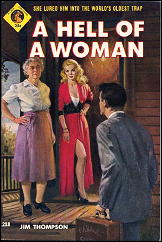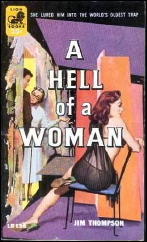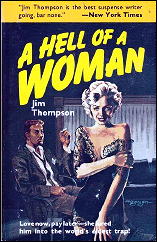Mon 6 Jun 2011
JIM THOMPSON’S A HELL OF A WOMAN,
by Curt J. Evans
JIM THOMPSON – A Hell of a Woman. Lion #218, paperback original. Reprint editions include: Lion Library #138, pb, 1956; Black Lizard/Creative Arts #77, softcover, 1984; Vintage Books, softcover, 1990.

In a comment following Dan Stumpf’s recent review of Jim Thompson’s Savage Night, I mentioned my dislike of Thompson’s influential novel (widely acknowledged as a genre masterpiece), The Killer Inside Me. I do not deny the artistry of this narrative of a deeply disturbed mind, but the brutality and viciousness of it all was quite off-putting to tenderhearted me.
But I have persevered and finally read a second Thompson, another of his most-highly-regarded tales, A Hell of a Woman. And I am pleased to report that not only do I respect the artistry, I actually enjoyed the read this time — though the events described are nearly as lurid and depraved as those in The Killer Inside Me.
Hell chronicles the fateful collision of salesman Frank “Dolly” Dillon with the household of a really quite nasty old lady and her niece, the sexy (and really quite stacked) Mona Farrell. The tight-fisted and not overly scrupulous aunt whores her daughter out to various men, you see, so that she need not pay cash to these men for services rendered.

So if auntie wants some yard work done or hankers after a sparkly new set of flatware, say, the man who has such to offer is invited to visit Mona’s bedroom. If Mona doesn’t thereupon put out, Mona gets knocked about (auntie wields a mean cane at the age of about seventy).
Dolly is married to Joyce, a woman he has tired of, and he is attracted to Mona, who he sees as essentially virginal and innocent and sweet, even though auntie has handed her over by now to the army, navy, air force and marines, figuratively speaking.
Let’s let Dolly tell it in his own inimitable words:
Invited by such thoughts, murder comes to visit and makes itself at home….
The plot, which also involves Dolly’s diddling of the accounts of the business for which he works, the Pay-E-Zee Stores (in its own way as nightmarish a concern as Old Lady Farrell’s house), is pleasingly intricate and actually took some twists and turns that surprised me.

I came to realize A Hell of a Woman is less a crime story per se than a tale about the onset of criminal madness (which I think can be said about much of Thompson’s work). The progressive deterioration of Dolly’s mind, culminating in the famous split narrative conclusion, is fascinating, in its repugnant way (like the current Casey Anthony trial).
I found Dolly less monstrous than the charming gentleman whose deeds are remorselessly chronicled by Thompson in The Killer Inside Me; yet Dolly, by golly, is no day at the beach or picnic on a Sunday afternoon. If you won a “Spend a Day with Dolly” contest, you’d be thinking twice about accepting the “prize,” if you get me.
Here, for example, is Dolly as a restaurant critic:

Dolly, one may come to realize, has women issues. In fact, though I never felt that the novel’s young women, Mona and Joyce, were as sufficiently-characterized as the men (some of the motivations seemed dubious or nebulous), this novel turns the whole noir femme fatale tradition on its pretty head, or so it seemed to me — though you would never guess this from the Vintage Crime/Black Lizard cover of the 1990 paperback edition.
And the ending is something that has to be read to be believed. Freud would have loved to have been able to analyze it, I’m sure.
The Black Lizard paperback edition also tells us that Hell is Thompson’s “homegrown version of Crime and Punishment.” I know Thompson has been called the “Dimestore Dostoevsky,” but it seems to me that he and the Russian are quite different personalities. Certainly it is difficult for me to glimpse redemption in the final hellish scene of Hell. Rather, it seems the grisly climax of the darkest nightmare.
In short: Awfully impressive, but also impressively awful.
June 7th, 2011 at 12:34 am
I enjoy this form of criticism. I did it with EIGHTBALL BOOGIE where it is less a review for readers and more an autobiographical study into one’s own reaction to a writer or book or genre.
Too many critics seem to believe their own point of view is judge and jury to a book or genre’s worth. Good critics challenge their own beliefs and try to discover what others see in any work.
Nice review, Curt.
June 7th, 2011 at 5:04 am
“I came to realize A Hell of a Woman is less a crime story per se than a tale about the onset of criminal madness”
Thompson to me never wrote crime stories but stories dealing with crime; the same might be said about 99% so-called “noir” fiction (Cain, Ellroy, Manchette, etc) which is one of the many reasons why I tend to eschew the genre entirely.
June 7th, 2011 at 3:10 pm
Xavier
I recall reading in James M. Cain’s biography that he didn’t think of himself as a “crime novelist” and didn’t have a high opinion of Hammett and Chandler (I will have to check this to make sure I have it exactly right). That’s something one never reads anywhere else!
And of course Chandler didn’t like his work either.
The makers of the original film version of Mildred Pierce mucked it around to better conform it with the film noir pattern.
I actually have a higher opinion of Thompson as a writer than Cain, but would not want to have to live off a steady diet of either man’s writing.
I’ll admit I miss puzzle problems in their work and Thompson’s world view is too unremittingly bleak and twisted for me as a preference. We always read that Chandler cared nothing for plotting, but he certainly did enough of it for someone who didn’t care about it! And he’s a romantic at heart–Thompson is nothing of the sort. I’d rather spend quality time with Marlowe than Thompson’s madmen.
Still, I thought this book was impressive.
June 7th, 2011 at 3:12 pm
Michael
I never see myself as the last word on a book’s quality! I agree with you that too many reviewers think “I didn’t like it” is synonymous with “It’s no good.”
June 8th, 2011 at 11:45 am
Thoughtful review, Curt.
Of course, Jim Thompson’s strength was his unmatched ability to burrow deep inside the criminal mind. I read somewhere that he was inspired by the 1948 Horace McCoy novel, KISS TOMORROW GOODBYE, a harrowing journey into the thoughts of a Phi Beta Kappa career criminal.
James M Cain was probably a little better a crafting a story, IMHO, but no one could touch Thompson for his depiction of off-the-rail sociopaths.
June 8th, 2011 at 3:04 pm
Curt:
Is Mona Farrell that old lady’s daughter or niece? Not that it matters to me, but….
Victor Berch
June 8th, 2011 at 3:14 pm
Victor,
Well, in the beginning it’s said she’s the niece and I was trying to be pretty careful with specific plot spoilers….
Mike, that’s interesting about McCoy. I admit I’m only familiar with one of his books. I see Kiss Tomorrow Goodbye was also a Cagney film, made a year after White Heat. Didn’t know that either!
June 10th, 2011 at 9:16 am
Jim Thompson wrote novels like no one else. I find the Thompson books endlessly fascinating!